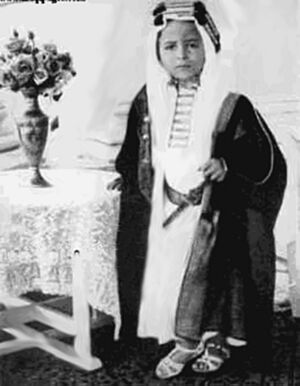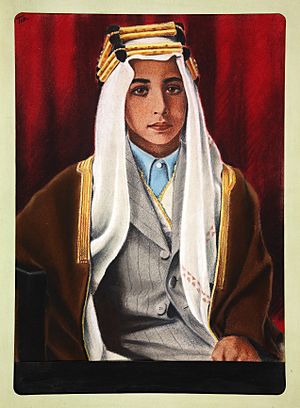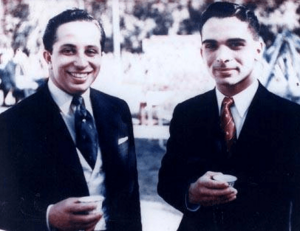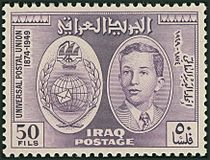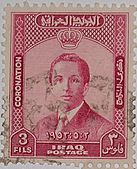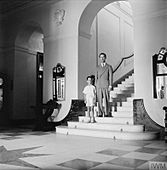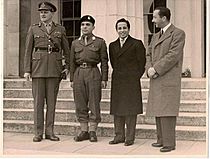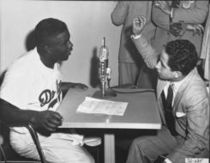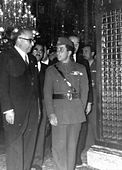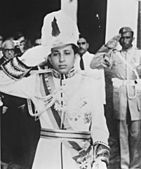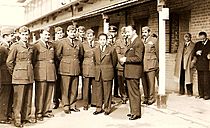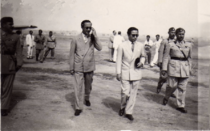Faisal II of Iraq facts for kids
Quick facts for kids Faisal II |
|||||
|---|---|---|---|---|---|
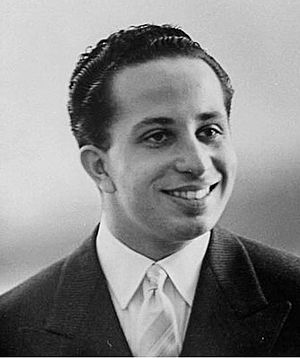
Faisal in the 1950s
|
|||||
| King of Iraq | |||||
| Reign | 4 April 1939 – 14 July 1958 | ||||
| Regency ended | 2 May 1953 | ||||
| Predecessor | Ghazi I | ||||
| Successor |
|
||||
| Prime Minister |
See list
Nuri al-Said (7 times)
Rashid Ali al-Gaylani (twice) Taha al-Hashimi Jamil al-Midfai (twice) Hamdi al-Pachachi Tawfiq al-Suwaidi (twice) Arshad al-Umari (Twice) Salih Jabr Muhammad as-Sadr Muzahim al-Pachachi Ali Jawdat al-Aiyubi (twice) Mustafa Mahmud al-Umari Nureddin Mahmud Muhammad Fadhel al-Jamali Abdul-Wahab Mirjan Ahmad Mukhtar Baban |
||||
| Regent (1939–1953) |
Prince 'Abd al-Ilah | ||||
| Born | 2 May 1935 Baghdad, Kingdom of Iraq |
||||
| Died | 14 July 1958 (aged 23) Baghdad, Arab Federation |
||||
| Burial | Royal Mausoleum, Adhamiyah | ||||
| Partner | Princess Sabiha Fazile Hanımsultan of Egypt (engaged, Faisal II died two weeks before the wedding) | ||||
|
|||||
| House | Hashemite | ||||
| Father | Ghazi I | ||||
| Mother | Aliya of Hejaz | ||||
| Religion | Sunni Islam | ||||
Faisal II (born May 2, 1935 – died July 14, 1958) was the very last King of Iraq. He became king when he was only three years old in 1939. He ruled until July 1958, when he was killed during a major event called the 14 July Revolution. This event ended the Hashemite monarchy in Iraq, which had lasted for 37 years. After that, Iraq became a republic.
Faisal was the only son of King Ghazi of Iraq and Queen Aliya. He became king after his father died in a car crash. Because he was so young, his uncle, Prince 'Abd al-Ilah, became his regent. A regent is someone who rules for a young king until he is old enough. In 1941, a group tried to take over the government, but the British helped restore his uncle to power. During World War II, Faisal and his mother went to the United Kingdom. There, he went to Harrow School with his cousin Hussein, who later became King of Jordan. Faisal officially became old enough to rule in May 1953, and the regency ended.
In 1958, Iraq and Jordan formed a partnership called the Arab Federation, and Faisal became its leader. However, many people in Iraq were unhappy with the government. In July 1958, a group of army officers led by Abd al-Karim Qasim took control in a coup d'état. King Faisal II and many members of his family were killed during this event.
Contents
Growing Up: Faisal's Early Life
Birth and Childhood Years
Faisal was the only son of King Ghazi of Iraq and Queen Aliya. His mother was the daughter of 'Ali bin Hussein, who was the King of Hijaz and a leader in Mecca. Faisal's father died in a car crash when Faisal was just three years old. His uncle, Prince 'Abd al-Ilah, became his regent and ruled for him until Faisal turned 18 in 1953. Faisal also had asthma, a breathing condition.
World War II and the 1941 Coup
Faisal's childhood happened during World War II. Iraq was officially allied with the British Empire. In April 1941, his uncle, the regent, was briefly removed from power by a military coup d'état. This group wanted Iraq to join the Axis powers. This led to the Anglo-Iraqi War. Germany tried to help, but it wasn't enough. The British and their allies helped restore Faisal's uncle to power. After the war, Iraq joined the United Nations.
When he was young, Faisal was taught at the royal palace with other Iraqi boys. During World War II, he lived for a while in England with his mother. As a teenager, Faisal went to Harrow School with his cousin Prince Hussein, who later became King Hussein of Jordan. They were good friends and even talked about joining their two countries. Faisal also drew many pictures during this time, showing scenes from the war like planes and bombs, but also peaceful things like birds and landscapes. These drawings give us a look into his thoughts during that busy time.
Visiting the United States in 1952
In 1952, when Faisal was 17, he planned a trip to the United States. He wanted to see their big projects, especially those related to farming and water. He told the New York press that these projects were "very much needed in our country."
On August 12, 1952, Faisal and his uncle, the regent, arrived in New York City. They toured the United Nations Headquarters and the Empire State Building. Faisal also famously went to a baseball game at Ebbets Field. He was rooting for the Brooklyn Dodgers. Many news channels covered his visit. He also toured the Radio City Music Hall and the Esso Oil Company. A few days later, he flew to Washington, D.C. and met President Harry Truman. He also met other famous Americans like Jackie Robinson.
Faisal's Time as King
Less than a year after his trip to the United States, Faisal turned 18 on May 2, 1953. This meant he was old enough to rule actively. He became king at a time when Iraq was changing quickly. He often asked his uncle, Prince 'Abd al-Ilah, and a wise politician named Nuri al-Sa'id for advice. Faisal's rule was known for being fair to different religions and for starting big projects, like irrigation systems, inspired by what he saw in the US. He also helped build public buildings like the al-Shawy Mosque.
However, his rule became harder because of growing problems like economic inequality and the rise of Pan-Arab nationalism. This was a movement that wanted all Arab countries to unite. Many people were unhappy that the United Kingdom still had a role in Iraq's affairs through treaties like the Baghdad Pact. This led to large protests and made people less loyal to the king.
Building a Modern Baghdad
During his time as king, Faisal started big plans to make Baghdad more modern. The goal was to improve roads and homes, build important public buildings, and train Iraqi architects. This project was possible because Iraq started getting more money from its oil in 1952. Faisal also created a group called the Development Board to help improve living conditions and build new things.
Many famous architects from around the world were invited to help, including Alvar Aalto and Walter Gropius. Some buildings designed during this time were even built many years later. For example, Frank Lloyd Wright was invited to design parts of Baghdad. He wanted to keep the city's unique character and was inspired by old Abbasid architecture.
Some people criticized these plans, saying they made Iraq too "Western". However, these projects were meant to help the city grow and develop.
The Arab Federation
On February 1, 1958, Syria and Egypt joined together to form the United Arab Republic. Iraq did not recognize this new union. This made the kingdoms of Iraq and Jordan want to become closer. So, on February 14, 1958, Iraq and Jordan formed their own partnership called the Arab Federation.
Because Faisal was the older leader in the Hashemite family, he became the head of this new federation. If he wasn't there, King Hussein of Jordan would lead. The federation was also open for other Arab countries to join.
The End of His Reign
Growing Opposition
Faisal's political situation became more difficult in 1956, with protests in cities like Najaf. Also, when Israel attacked Egypt (with help from Britain and France) over the Suez Canal, it made people even more angry about Iraq's alliance with Western countries. Groups who were against the government started working together. In February 1957, a "Front of National Union" was formed, including different political groups. Many army officers also started to support the idea of ending the monarchy. Even though the government tried to keep the army loyal with good benefits, it didn't work.
The 14 July Revolution
In the summer of 1958, King Hussein of Jordan asked Iraq for military help. Some units of the Royal Iraqi Army, led by Colonel Abd al-Karim Qasim, were on their way to Jordan. But instead, they marched into Baghdad on July 14 and took over the government. This event is known as the 14 July Revolution. King Faisal II told his guards not to fight and surrendered.
Around 8 AM, a captain named Abdul Sattar Sabaa Al-Ibousi ordered the King, his uncle Prince 'Abd al-Ilah, and other family members and servants to gather in the palace courtyard. There, they were tragically killed.
What Happened Next
Years later, an Iraqi historian asked Al-Ibousi about his part in Faisal's death. He said, "all I did was remember Palestine, and the trigger on the machine-gun just set itself off."
During the time of Saddam Hussein, Faisal II was reburied in the restored Royal Cemetery in Baghdad, next to his father.
Interests and Engagements
Faisal was interested in self-defense. He wrote an Arabic book called Ways to Defend Yourself in 1951. It was about judo and self-defense. He printed 50 copies and gave them to other kings and leaders, hoping it would be shared with young people in Arab countries.
Faisal was engaged three times. First, he asked to marry Princess Shahnaz Pahlavi, but she said no. Then, he was engaged to Princess Kiymet Hanım in 1957, but that engagement ended quickly. At the time of his death, he was engaged to Princess Sabiha Fazile Hanımsultan. They were supposed to get married just two weeks after he died.
Faisal in Pop Culture
- Some people think that the character of Prince Abdullah of Khemed in the comic book series The Adventures of Tintin was inspired by young King Faisal.
- Footage of Faisal was shown in an episode of The Rock 'n' Roll Years about the 1958 coup.
Military Ranks
Faisal held several important military ranks:
- Admiral of the Fleet, Royal Iraqi Navy.
- Field Marshal, Royal Iraqi Army.
- Marshal of the Royal Iraqi Air Force.
- Air Vice-Marshal (honorary), Royal Air Force.
Gallery
-
Jackie Robinson interviews Faisal II during his visit to the United States, 1952
Namesakes
Martyr Faisal II College is a military school in Jordan named after him.
See also
 In Spanish: Faysal II de Irak para niños
In Spanish: Faysal II de Irak para niños
- The late Sharif Ali bin al-Hussein – A cousin of King Faisal II who wanted to establish a constitutional monarchy in Iraq.
- Prince Ra'ad, head of the royal house of Iraq.
- Nuri al-Said – The Prime Minister of Iraq who was also killed during the 1958 coup.
- Arab Federation, the short-lived union between Jordan and Iraq where Faisal became its head of state.
- History of Iraq.


